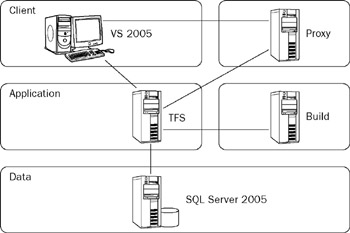Chapter 24: Deployment and Administration
Overview
In previous chapters, you learned how to use the individual features of Visual Studio 2005 Team System. To deploy Team System within a corporate environment, you must know how the components fit together conceptually and the important steps to effectively administer the tools.
Within your development environment, you can also count on your build server, test rigs, and proxies to enable you to connect Team Foundation Server to geographically distributed teams. It is important to note that the current version of Team System has been designed for teams of up to 2,000 users. (See Brian Harry's blog for details about capacity planning and scalability — http://www.blogs.msdn.com/bharry/.) Microsoft is internally introducing Team System within its own product groups, and you can expect future versions of Team System to support and scale to many more users.
If you do have a large number of developers to work with, you can optionally set up several build servers to distribute your builds. The Team Foundation Proxy will help you increase performance by caching your source control files. Finally, you can use the test controllers and rigs to distribute your load tests.
In Chapter 18, you learned a little about the three logical tiers in Team System. In this chapter, you'll get a clearer idea of the interplay between the components and how you can administer the product from an operational perspective. Figure 24-1 shows an overview of the primary logical tiers of Team System and how they interact with each other.

Figure 24-1
| Important | The above diagram is a simplified architectural view. It does not account for situations where you may, for example, want to set up multiple Team Foundation Build servers or set up Team Foundation Build on a client. |
Configuring Team System and Team Foundation Server can be quite challenging, especially when you're trying to integrate it within Active Directory, with stringent security requirements and multi-domain network topologies. Many of these topics are out of scope for the book, however; the best source of current information can be found on your CD or DVD media for Team Foundation Server. It includes two useful and detailed guides — the Team Foundation Server Installation Guide and the Team Foundation Server Administrators Guide.
Next in the chapter, you will find out how to set up your operations team and plan a deployment (using several common scenarios). You'll also get an overview of administrative details such as backup/recovery, tools migration, and general licensing strategies.
| Note | A great source of information for all things Team System is Rob Caron's popular blog. (Rob is partly responsible for the Team System documentation.) You can access Rob's site by visiting http://www.blogs.msdn.com/robcaron/. |
EAN: 2147483647
Pages: 220